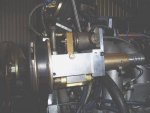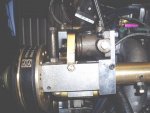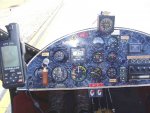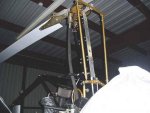KenSandyEggo
Platinum Member
- Joined
- Mar 29, 2004
- Messages
- 3,657
- Location
- Charlotte, NC
- Aircraft
- McCulloch J2
- Total Flight Time
- approx. 1400+
I got the hydraulic activator bled properly with my buddy Reis Evans assisting....actually, he did most of the work because he knew what he was doing. The $52 piece-of-crap suction pump sat on the floor after it wouldn't work properly and we used the handy oil squirt-can. Put lock nuts on the activator bolt as it started slipping through the pre-drilled hole without them. Pulled her outside and started her up and let the engine warm up a little. I pulled the handle on the stick and that thing grabbed like it suddenly welded the clutch-face to the plate. I let go and began easing her in, but it takes a light touch (and some more practice) to get her going without lugging it and twisting the mast. I finally locked it in around 75 rrpm and started adding power as needed. Got up to 206 at 2000 engine rpm and stayed there.
After I stopped, Reis told me that he thought the mast was twisting too much and to let him do it so I could watch. Weeeeel, Reis didn't have the feel of it and locked it in too soon and the mast twisted some and pulled the lower end of the prerotator cable out of it's metal sheath. The inner cable wound into a ball and then it sprayed grease all over the engine, prop and tail.
That was one of my ideas that didn't work too well. Remember, I had my cable shortened as much as possible to eliminate as much bend and friction as I could? If it were a couple inches longer, it would have been O.K. Reis suggested that the upper mast (cheek plates) be strengthened to counteract all the torque. We can install more aluminum squares, or as Reis suggested, fill the space with oak as the lower mast is. The options are to fill in the existing spaces between the aluminum channels or take them out and use one solid piece of wood. It would take a little ingenuity at the bottom, as the cheek plates spread out to about 2.25 inches to fit around the lower mast. Some aluminum wedges would probably do the trick. The rest is 2 inches, so it would have to be tapered at the bottom 2 or 3 inches, probably with the wedges. Adding doublers to the cheek plates was another idea, but Reis thought the wood would work best.
Below are some pictures of the event. That's Reis (the big guy) and my friend Pat that I used to share an Ercoupe and hangar with. So anyway, everything worked great....until it broke. Back to the drawing board, but we're getting close.
I had a brainstorm on the way home in my car for a prerotator system using the best features of a cable drive and solid-shaft drive with no universal joints. I have to look up some components to see if they're affordable, like when did that ever stop me before? This will be great if it's doable, and I don't see why not. It'll eliminate the drawbacks of the cable system and the solid-shaft system. Igor! Where's my sandwich?
After I stopped, Reis told me that he thought the mast was twisting too much and to let him do it so I could watch. Weeeeel, Reis didn't have the feel of it and locked it in too soon and the mast twisted some and pulled the lower end of the prerotator cable out of it's metal sheath. The inner cable wound into a ball and then it sprayed grease all over the engine, prop and tail.
That was one of my ideas that didn't work too well. Remember, I had my cable shortened as much as possible to eliminate as much bend and friction as I could? If it were a couple inches longer, it would have been O.K. Reis suggested that the upper mast (cheek plates) be strengthened to counteract all the torque. We can install more aluminum squares, or as Reis suggested, fill the space with oak as the lower mast is. The options are to fill in the existing spaces between the aluminum channels or take them out and use one solid piece of wood. It would take a little ingenuity at the bottom, as the cheek plates spread out to about 2.25 inches to fit around the lower mast. Some aluminum wedges would probably do the trick. The rest is 2 inches, so it would have to be tapered at the bottom 2 or 3 inches, probably with the wedges. Adding doublers to the cheek plates was another idea, but Reis thought the wood would work best.
Below are some pictures of the event. That's Reis (the big guy) and my friend Pat that I used to share an Ercoupe and hangar with. So anyway, everything worked great....until it broke. Back to the drawing board, but we're getting close.
I had a brainstorm on the way home in my car for a prerotator system using the best features of a cable drive and solid-shaft drive with no universal joints. I have to look up some components to see if they're affordable, like when did that ever stop me before? This will be great if it's doable, and I don't see why not. It'll eliminate the drawbacks of the cable system and the solid-shaft system. Igor! Where's my sandwich?
Attachments
Last edited:











